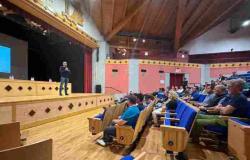Had it not been for Hugo Carvajal III and Robert Bradeen Jr. in February 2023 the USA would have mourned 131 people. But it was precisely the two pilots of the FedEx freight transport company who averted the worst air disaster since the terrorist attacks of September 11, 2001, noticing a few seconds after impact that there was already another plane on the landing strip, full of passengers, during take-off. The details of that incident – which emerged in its seriousness for the first time last October – were provided on 6 June this year during a hearing of the NTSB inquiry panel, the US federal body that investigates accidents in transport.
The audition
And it is in particular the animated reconstruction – complete with position, speed and minimum distances – that shows the near collision, the consequence of three factors. The first: air traffic controllers were not trained to manage aircraft movements in low visibility conditions. The second: the airport where the near-massacre occurred was not equipped with ground-based aircraft tracking systems, which would have helped to understand the situation. The third: the pilots of the jet with the passengers should have told the tower their exact position, thus requesting more time for take-off.
The dynamics
It’s February 4, 2023. At 6.34 in the morning at Austin-Bergstrom airport, Texas, the fog is thick. A FedEx Boeing 767 carrying three people and full of packages is approaching for landing along runway 18 left. At the same time, a Southwest Boeing 737 – the largest low-cost airline in the world – with 123 passengers, 2 pilots and 3 flight attendants approaches the runway to take off towards Cancún, Mexico.
The authorization
“Austin Tower, this is FedEx 1432,” they say from the cabin of the Boeing 767. “FedEx, cleared to land on runway 18 left,” says the controller. About four minutes later from the cabin of Southwest’s Boeing they contact the tower. «We are near runway 18 left», communicates the pilot of the American low cost plane. «You are authorized to take off», replies the controller who warns: «There is traffic three miles from you, a Boeing 767 is arriving». From the Boeing 737 they confirm that they have understood the message and stop at the “head” of the runway ready to leave.
The approach
Less than a minute later, at 6.39 and 29 seconds, the FedEx pilots ask the tower for confirmation about landing along runway 18 left. “Affirmative,” they reply from the ground. Adding that “a 737 is leaving before you”. The request for the cargo flight – the commander later explained – was made because the on-board systems noticed that the Southwest plane was stopped on the runway while they were getting off. At 6:40 and 10 seconds — when FedEx is 1.1 kilometers from the runway — the controller asks the Southwest pilots if they are departing. “We’re leaving now,” is the reply.
The order to stop
But when the cargo aircraft is at 12 meters above sea level and now above the runway, the pilots are able to see better in the fog and notice the silhouette of the Boeing 737 which is moving slowly along the asphalt strip. «Southeast stop takeoff!», they order from the FedEx cabin at 6.40 and 31 seconds. Three seconds later they tell the tower: «FedEx is getting back up», thus restoring power to the engines to postpone their landing and avoid the collision. At its point of minimum separation the two aircraft are 45-52 meters apart. Just over six seconds taking into account the speeds of the two jets.
The take-off
“Southwest you can turn right when you can,” says the tower at 6.40 and 44 seconds. «Negative», reply the pilots of the Boeing 737. They have reached such a speed that in their opinion it is no longer safe to postpone take-off. And in fact a few seconds later they lift off the ground and arrive at their destination without further problems. In the investigation, the controller said that he expected a faster departure from Southwest, an aircraft which he could not see due to the fog.
«Untrained» controllers
The controllers did not operate at their best – underline the investigators – because they were not trained to manage flights in low visibility conditions “in the two years prior to the accident”. Not only. “The controller had not worked shifts with low visibility conditions for at least a year prior to the accident” and “was not adequately prepared to manage traffic in low visibility conditions on the morning of the accident.” At that moment he could not be seen beyond 400 meters away.
The role of low cost pilots
But low-cost pilots also contributed to the chain of events. Investigators point out that they told the tower to be ready for takeoff when in reality they were 152 meters away from the assigned runway. “The pilots should have instead communicated that they needed more time to depart,” Warren Abrams, a former commander, said in the panel.
Anti-collision technology
Then there is the question of ground instrumentation. The airport was not equipped – and still is not – with devices that help controllers better monitor planes on the ground, particularly when there is fog. In particular, three systems were missing («Surface awareness initiative», «Approach runway verification», «Runway incursion device») which will be installed within this year.
The reactions
“This accident could have been catastrophic,” comments Jennifer Homendy, head of the NTSB. When he showed up at the June 6 hearing, FedEx flight co-pilot Robert Bradeen Jr. was greeted with an ovation in the room. In the previous days, Commander Hugo Carvajal III — not present at the hearing — recalled his irritation after hearing the controller authorize the Southwest Boeing to take off along the same runway where the cargo jet was landing.
Audio recordings
In the large folder describing the investigation we also read that from both planes involved it was not possible to recover the audio recordings of the pilots in the cabin and for this reason the only files were recovered from what they heard in the control tower. In the USA, the aircraft’s black box (“Cockpit voice recorder”) has a maximum duration of 2 hours and therefore overwrites the audio without direct intervention. For this reason, the NTSB highlights – for the umpteenth time – the usefulness of the standard which provides for a duration of 25 hours for audio files, so as to help in accident investigations. Standards that in the USA must be adapted “within 1 year” for new aircraft and “within 6 years” for old ones.





